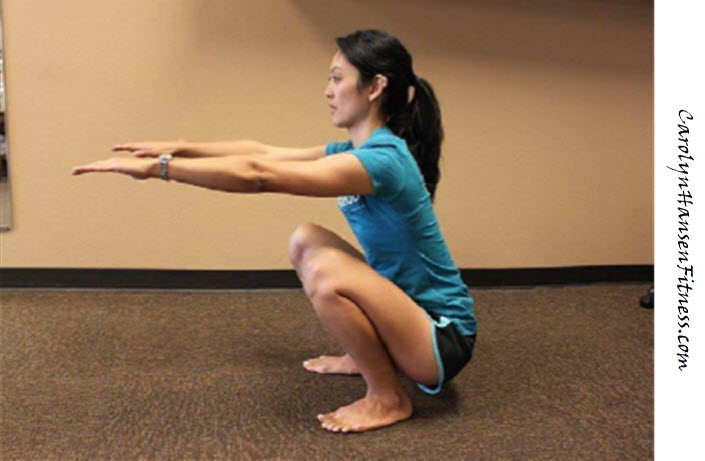
We now know, without doubt, that sitting for prolonged periods of time is devastating to our health and longevity. Our sedentary lifestyles are taking a toll and many people can no longer perform basic, functional, natural movements without suffering pain or inviting illness.
Believe it or not, the natural resting position of a person is not a chair or couch. It is a squatting position, commonly referred to as the flatfoot squat.
The humble squat is one of the most primal and effective human movements and can be defined as:
“the position achieved when the knees are fully flexed and the back of the thigh rests against the calf muscles while the heels are kept flat on the ground.”
The deep squat is a position that either contracts or stretches many of our muscles to their full range of motion. This is great because it means the muscles will be active rather than completely shut off like they are when we are slouching in a chair or on a couch.
As the number one hip and lower back exercise to increase mobility and reduce injury, it is one of the most basic, fundamental and natural human postures for the body. Ongoing anecdotal and scientific evidence has shown that there are tons of benefits to sitting in a deep squat for even a single minute per day. Everything from mobility to gastrointestinal health is improved by hanging out in a deep squat.
When we were children squatting came easy and natural to us. Unfortunately, as we age, we lose our ability to ‘hang out’ in this position. Why? Basically a lack of practice. The human body is a “use it or lose it” machine and that goes for all joints and muscles including those used while squatting.
Deep squats are great for supporting spinal health as well as aiding physiological processes in our bodies, such as digestion and elimination. They are an important exercise for countering the damage caused by the activities of modern society. They keep the hip joints healthy and mobile, improve lumbar disc health, relieve low back muscle pain and improve bowel health. Practicing them every day builds strength, stamina and agility and slowly reverses the effects of our increasingly sedentary modern life.
Performing a deep squat:
Getting started with deep squat holds doesn’t take much. Simply drop down into a squat where your hip crease is lower than the tops of the knees and hang out. The key is that you go well past parallel – and hold it.
Position your heels at about hip distance width and point your toes slightly outward. How close do your heels come to the ground? How comfortable is this in your knees, hips and low back?
Western cultures rely heavitly on chairs and sitting for extended periods of time, so even attempting a squatting posture, let along practicing it for any length of time is too difficult for most. Sadly, despite the health benefits, it’s likely that few westernized people could sit comfortably in a deep squat for any length of time.
On the other hand, non-westernized societies have routinely crouched down into a resting squat for nearly every task from relaxing to working, cooking, teaching and even socializing. Because of this, they don’t experience the long list of physical ailments and health issues so prevalent to Western cultures and socieites.
Health Risks –
Lack of deep squatting can result in conditions such as:
• Constipation
• Hemorrhoids
• Colitis (inflammation of the colon)
• Colon cancer
• Crohn’s disease (a type of inflammatory bowel disease)
• Diver-tic-u-litis (formation of pouches in the wall of the colon and consequent
inflammation of one of these pouches)
• Prostate disorders
• Hernia (a part of the stomach gets pushed through a tear or weakness in the
diaphragm)
• GERD (gastroesophageal reflux disease – stomach acid flows back into the
esophagus)
• Sexual dysfunction
Make it a daily habit to hang out in this position. Simply squat down and set a timer for one minute, hang out there and do a task of some sort, or just take that time to do a little mindfulness meditation, breathing, and relaxation. Either way, it’s going to be a big supporter of your health and longevity
You can learn more about the benefits that deep squatting offers and how practicing it positively affects/plays into the health of every system within our body.
Learning to squat properly is more than a game changer – it’s a life changer. You will notice fewer aches and pains. You will reduce your risk of injury. You will build or maintain more muscle tone across your body.
Best of all, you are likely to see your physical performance improve – from doing everyday tasks and activities easier to running faster, smashing a ball farther, punching harder – in just about every activity you do.
Grab your FREE copy of:
The Sitting Antidote and learn:
A SIMPLE 3 SECOND TEST to determine how much JOINT PAIN RELIEF you might get from assuming this ancient “stand-in” for sitting…
For more tools and resources from Carolyn Hansen to assist you in attaining your health and fitness goals please visit:
